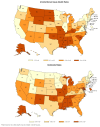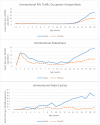The Epidemiology of Unintentional and Violence-Related Injury Morbidity and Mortality among Children and Adolescents in the United States
- PMID: 29597289
- PMCID: PMC5923658
- DOI: 10.3390/ijerph15040616
The Epidemiology of Unintentional and Violence-Related Injury Morbidity and Mortality among Children and Adolescents in the United States
Abstract
Injuries and violence among young people have a substantial emotional, physical, and economic toll on society. Understanding the epidemiology of this public health problem can guide prevention efforts, help identify and reduce risk factors, and promote protective factors. We examined fatal and nonfatal unintentional injuries, injuries intentionally inflicted by other (i.e., assaults and homicides) among children ages 0-19, and intentionally self-inflicted injuries (i.e., self-harm and suicides) among children ages 10-19. We accessed deaths (1999-2015) and visits to emergency departments (2001-2015) for these age groups through the Centers for Disease Control and Prevention's (CDC) Web-based Injury Statistics Query and Reporting System (WISQARS), and examined trends and differences by age, sex, race/ethnicity, rural/urban status, and injury mechanism. Almost 13,000 children and adolescents age 0-19 years died in 2015 from injury and violence compared to over 17,000 in 1999. While the overall number of deaths has decreased over time, there were increases in death rates among certain age groups for some categories of unintentional injury and for suicides. The leading causes of injury varied by age group. Our results indicate that efforts to reduce injuries to children and adolescents should consider cause, intent, age, sex, race, and regional factors to assure that prevention resources are directed at those at greatest risk.
Keywords: adolescents; children; epidemiology; homicide; injury; suicide.
Conflict of interest statement
The authors declare no conflict of interest.
Figures









References
-
- Centers for Disease Control and Prevention Web-Based Injury Statistics Query and Reporting System (WISQARS) [(accessed on 9 August 2017)]; Available online: https://www.cdc.gov/injury/wisqars/
-
- Centers for Disease Control and Prevention Tools for Categorizing Injuries Using ICD Codes. [(accessed on 1 July 2017)]; Available online: https://www.cdc.gov/nchs/injury/injury_tools.htm.
-
- Ballesteros M. Motor vehicle occupant mortality coding: Comparison of NVSS and FARS; Proceedings of the SAVIR 2017 Conference: Innovations in Injury Prevention Science; Ann Arbor, MI, USA. 18–20 September 2017.
MeSH terms
LinkOut - more resources
Full Text Sources
Other Literature Sources
Medical

